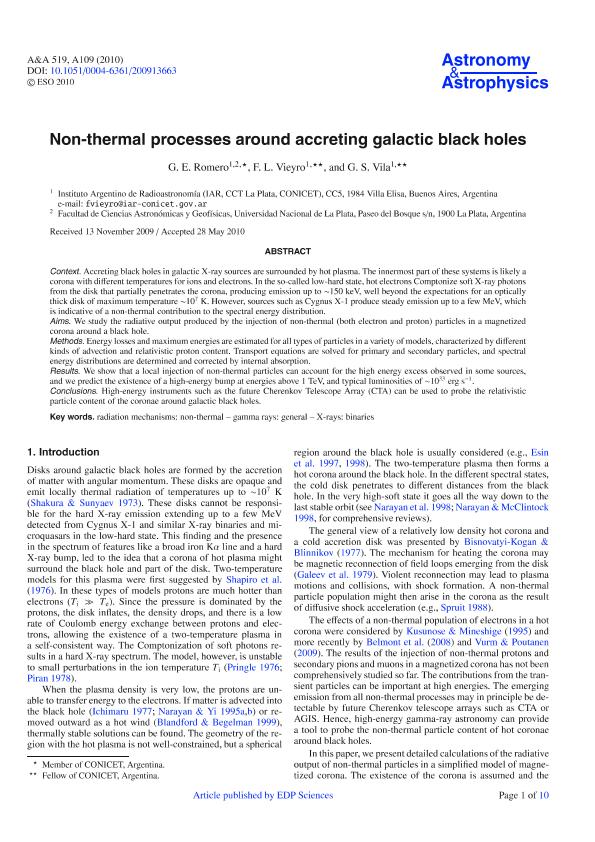Artículo
Non-thermal processes around accreting galactic black holes
Fecha de publicación:
09/2010
Editorial:
EDP Sciences
Revista:
Astronomy and Astrophysics
ISSN:
0004-6361
Idioma:
Inglés
Tipo de recurso:
Artículo publicado
Clasificación temática:
Resumen
Context. Accreting black holes in galactic X-ray sources are surrounded by hot plasma. The innermost part of these systems is likely a corona with different temperatures for ions and electrons. In the so-called low-hard state, hot electrons Comptonize soft X-ray photons from the disk that partially penetrates the corona, producing emission up to ∼150 keV, well beyond the expectations for an optically
thick disk of maximum temperature ∼107 K. However, sources such as Cygnus X-1 produce steady emission up to a few MeV, which is indicative of a non-thermal contribution to the spectral energy distribution.
Aims. We study the radiative output produced by the injection of non-thermal (both electron and proton) particles in a magnetized corona around a black hole.
Methods. Energy losses and maximum energies are estimated for all types of particles in a variety of models, characterized by different kinds of advection and relativistic proton content. Transport equations are solved for primary and secondary particles, and spectral energy distributions are determined and corrected by internal absorption.
Results. We show that a local injection of non-thermal particles can account for the high energy excess observed in some sources, and we predict the existence of a high-energy bump at energies above 1 TeV, and typical luminosities of ∼1033 erg s−1.
Conclusions. High-energy instruments such as the future Cherenkov Telescope Array (CTA) can be used to probe the relativistic particle content of the coronae around galactic black holes.
Archivos asociados
Licencia
Identificadores
Colecciones
Articulos(CCT - LA PLATA)
Articulos de CTRO.CIENTIFICO TECNOL.CONICET - LA PLATA
Articulos de CTRO.CIENTIFICO TECNOL.CONICET - LA PLATA
Articulos(IAR)
Articulos de INST.ARG.DE RADIOASTRONOMIA (I)
Articulos de INST.ARG.DE RADIOASTRONOMIA (I)
Citación
Romero, Gustavo Esteban; Vieyro, Florencia Laura; Vila, Gabriela Soledad; Non-thermal processes around accreting galactic black holes; EDP Sciences; Astronomy and Astrophysics; 519; 9-2010; 1-11
Compartir
Altmétricas




